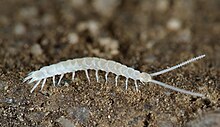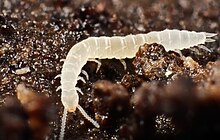
Millipedes are a group of arthropods that are characterised by having two pairs of jointed legs on most body segments; they are known scientifically as the class Diplopoda, the name derived from this feature. Each double-legged segment is a result of two single segments fused together. Most millipedes have very elongated cylindrical or flattened bodies with more than 20 segments, while pill millipedes are shorter and can roll into a tight ball. Although the name "millipede" derives from Latin for "thousand feet", no species was known to have 1,000 or more until the discovery in 2020 of Eumillipes persephone, which can have over 1,300 legs. There are approximately 12,000 named species classified into 16 orders and around 140 families, making Diplopoda the largest class of myriapods, an arthropod group which also includes centipedes and other multi-legged creatures.

Centipedes are predatory arthropods belonging to the class Chilopoda of the subphylum Myriapoda, an arthropod group which includes millipedes and other multi-legged animals. Centipedes are elongated segmented (metameric) creatures with one pair of legs per body segment. All centipedes are venomous and can inflict painful stings, injecting their venom through pincer-like appendages known as forcipules or toxicognaths, which are actually modified legs instead of fangs. Despite the name, no centipede has exactly 100 pairs of legs; number of legs ranges from 15 pairs to 191 pairs, always an odd number.

Pauropods are small, pale, millipede-like arthropods. Around 830 species in twelve families are found worldwide, living in soil and leaf mold. They look rather like centipedes, or millipedes, and may be a sister group of the latter. However, this is controversial, as a close relationship with Symphyla has also been posited.
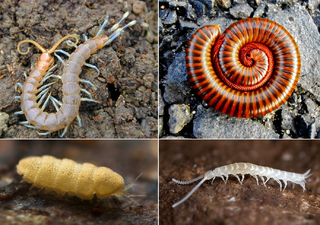
Myriapods are the members of subphylum Myriapoda, containing arthropods such as millipedes and centipedes. The group contains about 13,000 species, all of them terrestrial.

Glomerida is an order of pill-millipedes found primarily in the Northern Hemisphere. Also known as northern pill millipedes, they superficially resemble pill-bugs or woodlice, and can enroll into a protective ball. They have twelve body segments, 17 to 19 pairs of legs, and males have enlarged rear legs involved in mating. The order includes about 30 genera and at least 280 species, including Glomeris marginata, the common European pill-millipede. The order contains members in Europe, South-east Asia and the Americas from California to Guatemala. Although historically considered closely related with the similar sphaerotheriidans that also enroll, some DNA evidence suggest they may be more closely related to glomeridesmidans, a poorly known order that does not enroll.
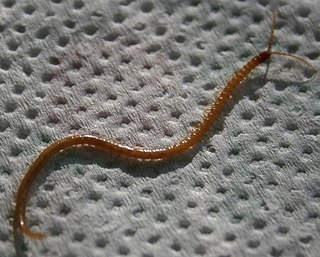
Geophilus flavus is a terrestrial, soil-dwelling, species of centipede in the Geophilidae family. G. flavus occurs in a range of habitats across central Europe, North America, Australia and other tropical regions. Geophilomorph centipedes, like centipedes generally, are primary predators, hunting predominantly in underground soil burrows or above ground leaf litter. Their consumption behaviours are influenced by environment and seasonal factors. Given their lack of economic value and marginal medical significance, G.flavus remains largely understudied in mainstream research. Some recent studies have detailed the evolutionary development of G.flavus and Geophilidae generally, illustrating developed predatory features like forcipule venom glands.

The Geophilidae are a polyphyletic, cosmopolitan family of soil centipedes in the superfamily Geophiloidea containing the mostly defunct clades Aphilodontidae, Dignathodontidae, Linotaeniidae, Chilenophilinae, and Macronicophilidae.

Himantariidae is a monophyletic family of centipedes in the order Geophilomorpha and superfamily Himantarioidea, found almost exclusively in the Northern Hemisphere. Centipedes in this family feature a short head with a concave labral margin bearing a row of denticles, a single dentate lamella and some pectinate lamellae on each mandible, second maxillae with strongly tapering telopodites and slightly spatulate claws, and a stout forcipular segment with short forcipules and a wide tergite; the ultimate legs usually have no pretarsus, and the female gonopods are distinct and biarticulate.
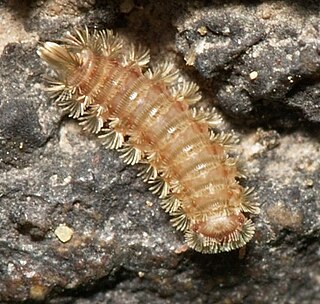
Polyxenida is an order of millipedes readily distinguished by a unique body plan consisting of a soft, non-calcified body ornamented with tufts of bristles – traits that have inspired the common names "bristly millipedes" or "pincushion millipedes". There are at least 86 species in four families worldwide, and are the only living members of the subclass Penicillata.

Siphoniulus is a poorly known genus of millipede containing only two living species: S. alba from Indonesia, and S. neotropicus from Mexico and Guatemala. An additional two fossil species are known from Cretaceous amber. Siphoniulus species are the only members of the family Siphoniulidae and order Siphoniulida, making Siphoniulida the smallest millipede order. Few specimens are known, and their classification is contentious, although most recent studies place them as basal members of the Helminthomorpha.
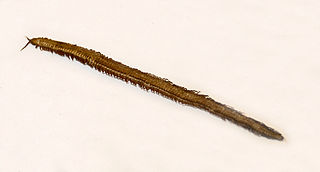
Oryidae is a monophyletic family of soil centipedes belonging to the superfamily Himantarioidea.
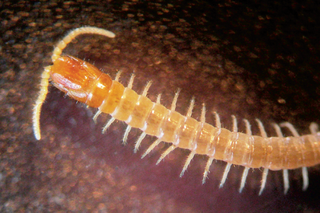
Mecistocephalidae is a monophyletic family of centipedes in the order Geophilomorpha. It is the only family in the suborder Placodesmata. Most species in this family live in tropical or subtropical regions, but some occur in temperate regions. This family is the third most diverse in the order Geophiliomorpha, with about 170 species, including about 130 species in the genus Mecistocephalus.
Linotaeniidae are a monophyletic clade of soil centipedes in the family Geophilidae found mostly in the temperate regions of the Holarctic as well as the south Andes. Species in the clade Linotaeniidae are characterized by a body that usually tapers toward the anterior tip; mandibles with a single pectinate lamella; second maxillae with coxo-sternite usually undivided and claws without projections; forcipular segment short, with tergite remarkably wide, forcipules evidently tapering; coxal organs opening through distinct pores on the ventral surface of the coxo-pleura. The number of legs in this clade varies within as well as among species and ranges from as few as 31 pairs of legs to as many as 83 leg pairs. Compared to most families in the suborder Adesmata, this clade features a modest number of leg-bearing segments and limited variation in this number within each species.

Schendylidae is a family of centipedes in the order Geophilomorpha.

Scolopendrellidae is a family of symphylans in the class Symphyla. There are about 9 genera and at least 100 described species in Scolopendrellidae.

Scutigerellidae is a family of pseudocentipedes in the class Symphyla. There are about 5 genera and at least 140 described species in Scutigerellidae.

Scutigerella immaculata, commonly known as the garden symphylan or glasshouse symphylid, is a species of myriapod in the family Scutigerellidae. It may have originated in Europe but now has a cosmopolitan distribution and can be a pest of crops.
Dignathodontidae is a monophyletic clade of soil centipedes in the family Geophilidae found in the Mediterranean region, extending to Macaronesia, Caucasus, and western and central Europe. The clade is characterized by a gradually anteriorly tapered body, a short head with non-attenuated antennae, and a poorly sclerotized labrum with tubercles. The number of legs in this clade varies within as well as among species and ranges from 43 pairs to 153 pairs of legs. Species in this clade tend to have more leg-bearing segments and greater intraspecific variability in this number than generally found in the family Geophilidae.
Gonibregmatidae are a paraphyletic family of soil centipedes belonging to the superfamily Geophiloidea.
Gonibregmatus is a genus of centipedes in the family Gonibregmatidae. It was described by British entomologist George Newport in 1843.
